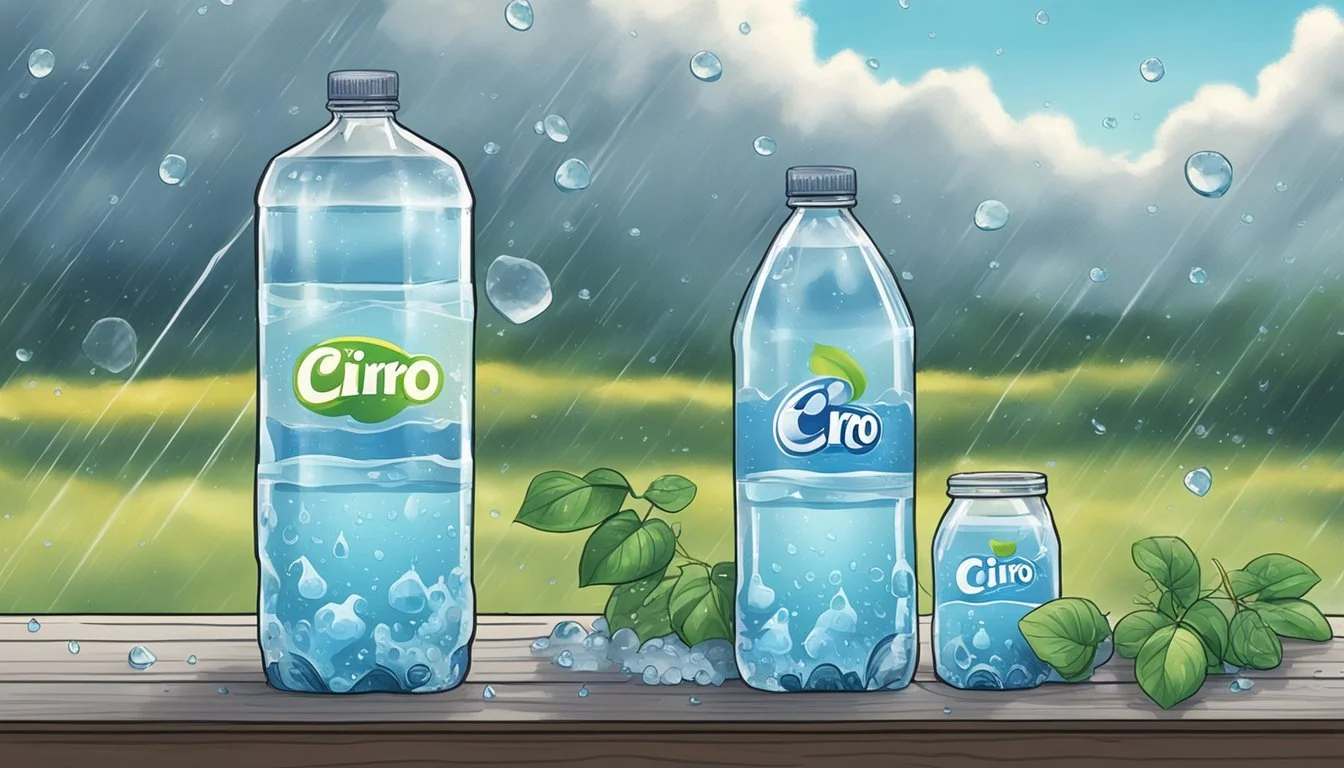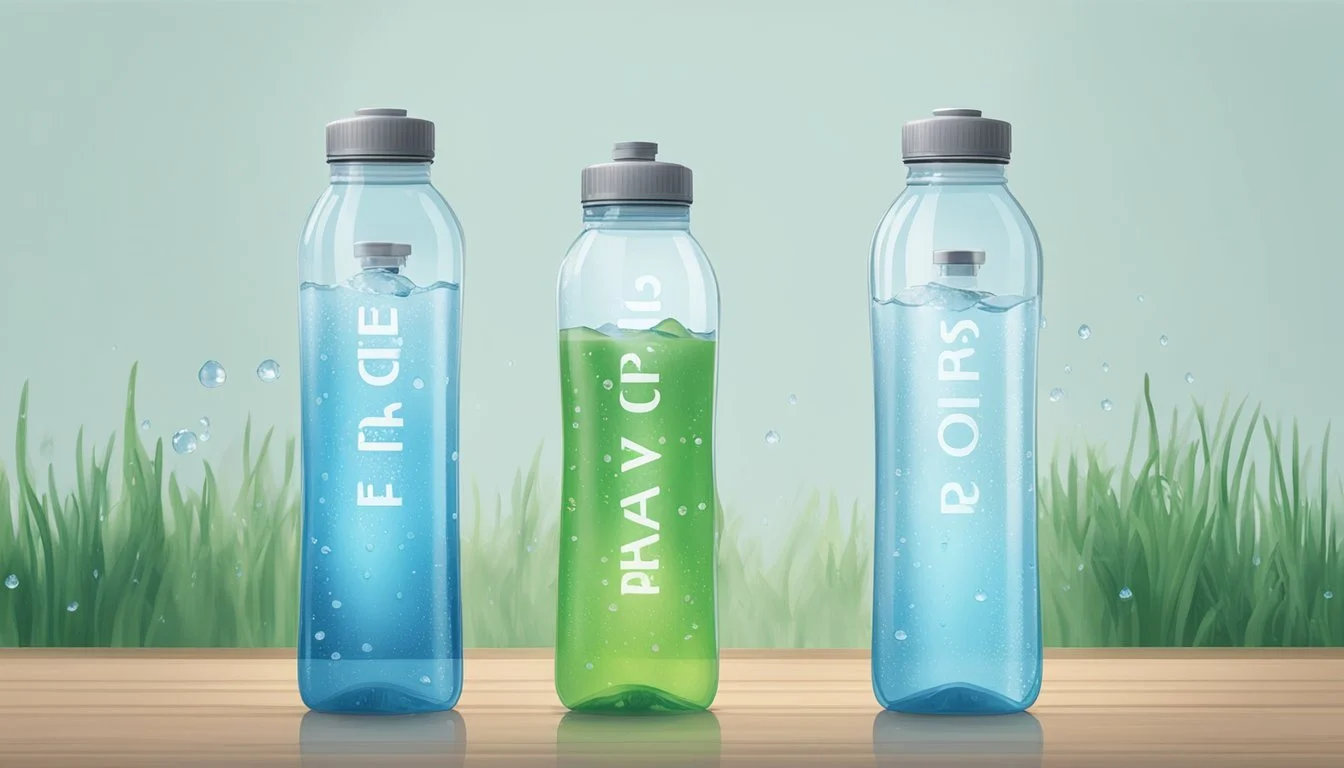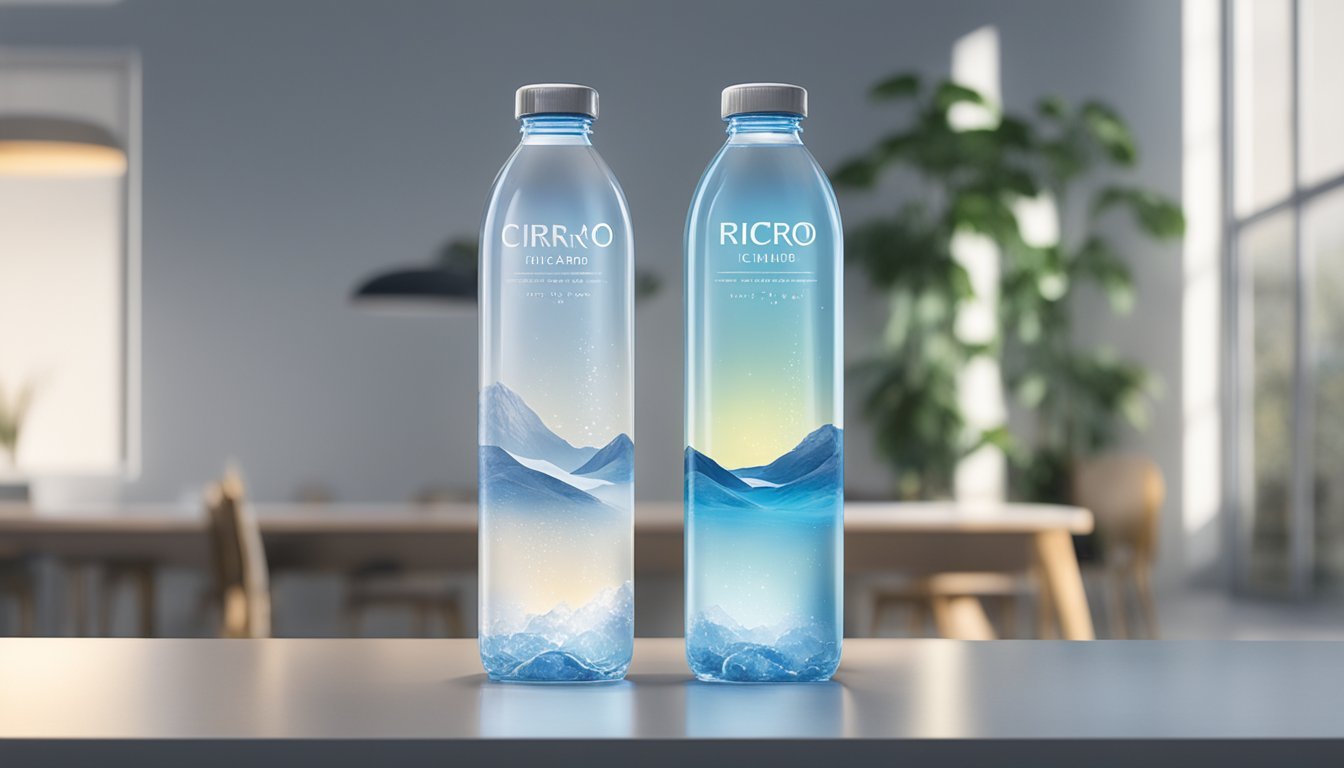Cirro vs. Richard’s Rainwater
A Comparative Analysis of Bottled Water Quality
When it comes to choosing a bottled water, discerning consumers often weigh the options. Two prominent names stand out in the market: Cirro and Richard's Rainwater. Each brand brings unique qualities to the table, making the decision a matter of understanding their distinct offerings.
Cirro, a name synonymous with purity, offers natural spring water sourced from pristine locations. On the other hand, Richard's Rainwater captures rain before it ever hits the ground, ensuring a level of purity and sustainability unmatched by traditional sources. Their innovative approach not only helps in water conservation but also provides exceptionally pure drinking water.
In the debate of which bottled water is better, it ultimately boils down to personal preference and values. Cirro emphasizes natural origins and traditional collection methods, while Richard's Rainwater highlights environmental sustainability and a modern take on water harvesting. This intriguing comparison is what makes the choice between these two brands so compelling for consumers.
Understanding Bottled Water
Bottled water comes in various types and adheres to specific standards to ensure safety. It also has a significant impact on the environment due to packaging and waste.
Types of Bottled Water
Bottled water can be still or sparkling. Still water is non-carbonated and may come from sources like springs or wells. Sparkling water is carbonated, either naturally or artificially.
Packaging varies, with glass bottles and plastic bottles being the most common. Glass is more sustainable but heavier. Plastic is lightweight but less environmentally friendly.
Understanding the differences helps consumers make informed choices. Availability in different packaging options and forms influences consumer preference and environmental impact.
Bottled Water Standards
The bottled water industry adheres to strict standards to ensure water safety. Regulations oversee the cleanliness and purity of bottled water.
Richard’s Rainwater, for instance, claims to meet stringent criteria, offering water cleaner than typical standards before treatment. Quality control is crucial to avoid contamination.
Filtration systems are often employed to remove impurities, as seen in Richard’s Rainwater’s chlorine-free process. Maintaining these standards is essential for consumer trust and safety.
Environmental Impact of Bottled Water
Bottled water has significant environmental implications. The production and disposal of plastic bottles contribute to pollution.
Glass bottles present a more sustainable option, though they are heavier and require more energy to transport.
Sustainability efforts by companies, like capturing rainwater before it hits the ground, help reduce environmental footprints. Innovations in packaging and water sourcing are key to minimizing damage to the environment.
Efforts like zero-waste filtration systems and efficient rain harvesting methods contribute to conserving water and reducing waste, promoting a more sustainable future.
The Rise of Rainwater Bottling
Rainwater bottling has gained significant traction due to its sustainability benefits and the inherent purity of rainwater. Companies are committed to collecting and purifying this resource, and innovative branding strategies help these products stand out in a competitive market.
Rainwater as a Drinking Source
Rainwater is naturally clean, often surpassing the purity of traditional groundwater or spring water sources. Companies like Richard’s Rainwater highlight this by emphasizing the rain's natural cleanliness. They assert that rainwater meets or exceeds strict bottled water standards without the need for added chemicals or treatments like chlorine or fluoride.
Rainwater’s appeal as a drinking source lies in its perceived purity and environmental benefits. By using rainwater, companies reduce the reliance on groundwater, which is often over-exploited.
Collection and Filtration Techniques
Collection sites are pivotal in ensuring the quality of bottled rainwater. Rainwater is typically collected from large surface areas such as rooftops, then directed into storage tanks. Advanced filtration systems are employed to ensure the water's purity.
The filtration process often includes multiple stages, such as sediment filters, activated carbon filters, and UV purification. This removes any potential contaminants while preserving the natural taste of rainwater. Notably, Richard’s Rainwater boasts comprehensive filtration that eliminates microplastics, PFAS, and other impurities.
Branding in the Rainwater Market
Branding plays a crucial role in the rainwater bottling industry. Companies emphasize the sustainability and purity of their products through packaging and marketing campaigns. Rainwater beverage makers often use recyclable materials like aluminum cans and glass bottles to appeal to environmentally conscious consumers.
Brands like Richard’s Rainwater differentiate themselves with FDA approvals and sustainability claims. The marketing often focuses on the superior cleanliness of rainwater, branding it as not just an alternative water source, but a premium product in its own right.
Rainwater bottling is positioned as both an eco-friendly and high-quality choice in the bottled water market.
Cirro Water Analysis
Cirro Water, known for its high-quality standards, stands out due to its meticulous sourcing and environmentally friendly packaging. Detailed insights into its water source, quality, packaging, and accessibility are provided below.
Cirro Water Source and Quality
Cirro sources its water from natural springs located in remote, pristine areas. These sources are rigorously protected to maintain the water’s purity. The company employs advanced filtration techniques to ensure that the water retains its natural minerals while removing any potential contaminants. Regular quality checks are conducted to uphold the highest standards of safety and purity. Users appreciate the clarity and refreshing taste, attributing it to the careful handling from source to bottle.
Cirro Packaging and Accessibility
Cirro is committed to sustainability, reflected in its choice of packaging. The company primarily uses glass bottles, which are fully recyclable and have a lower environmental impact than plastic. The design is sleek, making it convenient for both home use and on-the-go hydration. Additionally, Cirro water is widely accessible in various retail outlets and through direct online sales. Their distribution network ensures that consumers can easily purchase Cirro water, promoting a wider reach and availability.
Richard’s Rainwater Story
Richard Heinichen founded Richard’s Rainwater with a unique vision, transforming rainwater into a viable, potable water source through sustainable practices and innovative technology.
Richard Heinichen and His Vision
Richard Heinichen, an Austin, Texas resident, was driven by a personal desire to improve his own water quality. Frustrated with the effects of well water on his hair and laundry, Heinichen began collecting rainwater in the 1990s. This personal endeavor evolved into a bold vision for a business that could offer pure, sustainable drinking water. Heinichen’s creative approach laid the foundation for a brand that focuses on harnessing nature’s renewable resources.
Sustainability Initiatives by Richard’s Rainwater
One of the core tenets of Richard’s Rainwater is sustainability. The company utilizes proprietary technology to filter rainwater, ensuring it is safe for consumption. This process is virtually zero-waste, significantly reducing the environmental footprint. Additionally, Richard’s Rainwater packaging is 100% recyclable, embracing a full-circle sustainability model. By collecting water from rainwater collection sites, the brand ensures that there is more water available for drinking than through traditional methods, highlighting its commitment to the environment and renewable resources.
Product Offerings and Innovations
Richard’s Rainwater offers a variety of products, including still and sparkling rainwater, packaged in recyclable aluminum cans and glass bottles. This choice in sustainable packaging reflects their dedication to environmental responsibility. Furthermore, the company underwent a brand refresh to appeal to modern consumers, emphasizing a fresh, clean design that inspires people to choose rainwater as their preferred drink. By combining innovative filtration systems with appealing packaging, Richard’s Rainwater successfully positions itself as a leader in the market for sustainable bottled water.
Comparing Taste and Health Benefits
This section examines the distinct flavor profiles and health implications of choosing Cirro or Richard’s Rainwater as your bottled water of choice. Emphasis is placed on understanding how each brand could affect your taste preferences and health.
Flavor Profiles: Cirro vs. Richard’s Rainwater
Cirro is known for its clean, crisp taste, free from any chemical hints. It strives to balance mineral content, offering a refreshing and pure drinking experience. The absence of chlorine, fluoride, and ammonia in its composition enhances its natural flavor, appealing to those who prefer water with minimal aftertaste.
On the other hand, Richard’s Rainwater captures the essence of natural rain, providing a soft, slightly sweet flavor profile. It achieves this by sourcing its water directly from rain, ensuring no contact with urban pollutants. This results in a pure, naturally hydrating option that differentiates itself from traditional bottled waters.
Health Implications of Drinking Bottled Rainwater
Drinking Cirro ensures consumers avoid common additives like chlorine, fluoride, and ammonia, which are often present in municipal water supplies. This makes it a preferable choice for those seeking a clean water source without additional chemicals.
Richard’s Rainwater is not only free from these additives but also touts environmental benefits. By capturing rainwater, it avoids chemical processing altogether. Some health enthusiasts believe this natural method offers a purer form of hydration, potentially benefiting those sensitive to typical tap water contents.
Both brands provide pure, safe hydration options, but their processing methods and resultant health impacts present unique benefits for the informed consumer.
Market Presence and Distribution
Cirro and Richard’s Rainwater hold significant market positions, each leveraging strategic retail partnerships to expand consumer reach. Both brands target environmentally-conscious consumers, but their distribution strategies and brand presence differ.
Retail Partnerships and Availability
Cirro primarily distributes through major chains such as Whole Foods Market, Sprouts Farmers Market, and other health-oriented retailers. They also partner with local independent grocers to enhance accessibility in various regions. This widespread availability helps Cirro cement its presence in both urban and suburban markets.
Richard’s Rainwater has expanded its retail footprint significantly. It is available in national chains such as Kroger, Albertsons, H-E-B, and Natural Grocers. The company’s focus on eco-friendly practices aligns well with retailers emphasizing sustainability. Partnerships with these major chains ensure Richard’s Rainwater is readily accessible across the United States.
Consumer Reach and Brand Presence
Cirro targets a niche audience of health-conscious consumers who prioritize natural and sustainable products. The brand leverages its presence in Whole Foods Market and Sprouts Farmers Market to reach this demographic. Additionally, social media and influencer partnerships enhance its appeal, creating a strong digital presence that resonates with younger consumers.
Richard’s Rainwater has positioned itself as a pioneer in the bottled rainwater category. By being available in major retailers like Kroger, Albertsons, and H-E-B, the brand reaches a broad audience. Its national distribution and zero-waste production process significantly enhance its public image. Furthermore, Richard’s Rainwater’s recent expansion into sparkling water attracts consumers seeking variety in their beverage choices.
Both brands use distinct strategies to increase market presence, with Cirro focusing on health-centered stores and social media, while Richard’s Rainwater leverages national distribution and sustainable practices.
Environmental and Community Impact
Both Cirro and Richard's Rainwater place a strong emphasis on sustainability and community support, but their methods and achievements differ.
Eco-Friendly Practices and Certifications
Richard's Rainwater prides itself on its unique method of capturing and bottling rainwater. By catching rain before it touches the ground, they prevent storm runoff and contamination. The company boasts that this process saved over 400,000 gallons of water last year, enough to hydrate 2,000 people for a year. Rain, being a renewable source, aligns closely with sustainability goals.
Cirro, on the other hand, focuses on sustainable packaging and a closed-loop system. Their bottles are made from 100% recycled materials, and they have implemented a robust recycling program to ensure minimal waste. Cirro's production aims to be as environmentally friendly as possible by reducing carbon emissions and conserving water throughout the manufacturing process. Certifications from various environmental organizations underline Cirro's commitment to eco-friendly practices.
Support for Local Communities and Growth
Richard's Rainwater is deeply embedded in community support initiatives. The company regularly donates water to local communities and disaster-stricken areas. Their approach to hydrating change goes beyond just providing potable water; it includes fostering local community growth and resilience. These efforts underline their commitment to making a net-positive impact.
Cirro's community involvement includes partnerships with local conservation groups and educational programs that promote sustainability. These programs teach the importance of water conservation and sustainable living. Cirro's efforts in community support not only aim to benefit those directly involved but also strive to bring sustainable practices to a broader audience.
Both companies demonstrate a commitment to environmental sustainability and community support, employing different strategies to achieve their goals.
Conclusion
When choosing between Cirro and Richard's Rainwater, several factors come into play. Both brands offer unique qualities that cater to different preferences.
Quality: Richard's Rainwater prides itself on capturing rain before it hits the ground, ensuring purity. Cirro, on the other hand, might offer a different source but maintains high-quality standards.
Sustainability: Richard's Rainwater stands out with its use of the most renewable water source—rain—and its efforts to prevent storm runoff. This makes it a strong contender for those prioritizing eco-friendly options.
Bottled Water Choice: Consumers often base their choices on taste, availability, and environmental impact. Richard's Rainwater's focus on local collection and sustainability may appeal to environmentally conscious buyers. Cirro's quality and other features cater to a broader market.
Criteria Cirro Richard's Rainwater Quality High Standards Purity from Rain Sustainability Standard Practices Renewable Collection Environmental Impact Moderate Low
In comparison, each brand offers distinct advantages. Richard's Rainwater appeals to those looking for pure, sustainable water options, while Cirro provides consistent quality.
Ultimately, the better bottled water between Cirro and Richard’s Rainwater depends on individual preferences regarding taste, environmental values, and overall quality.







